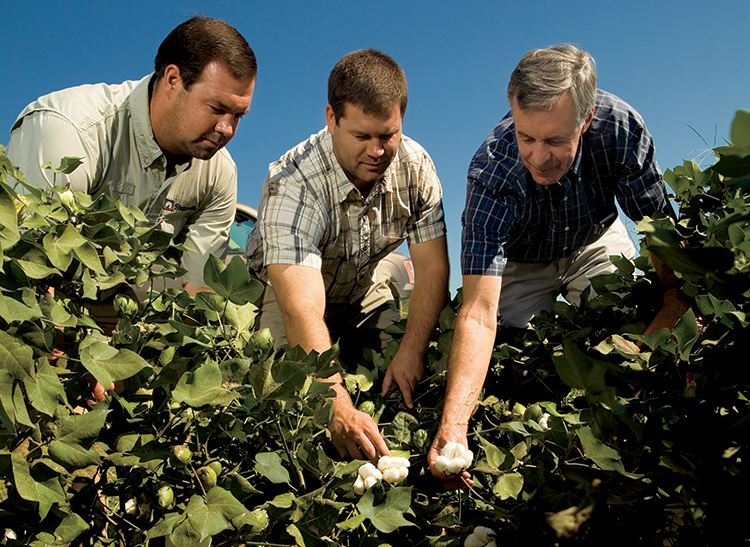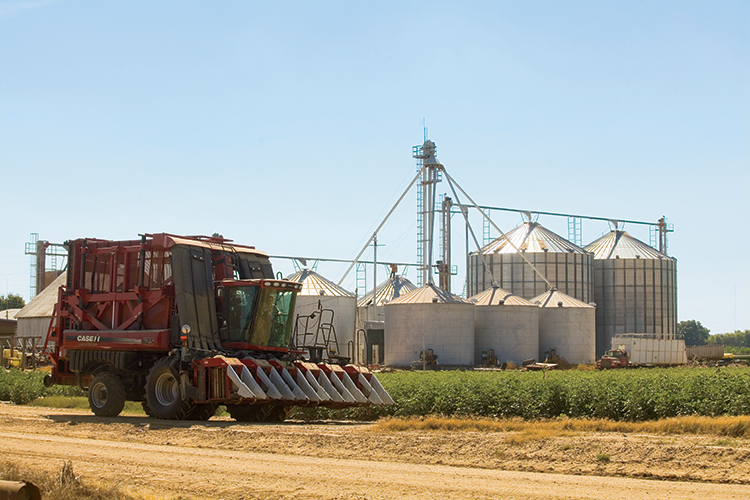Home > Arkansas > Arkansas Crops & Livestock > High Cotton in Arkansas
High Cotton in Arkansas
Arkansas’s stake in cotton reaches far beyond its borders. Did you know U.S. paper money is actually made of 75 percent cotton and 25 percent linen? And that 150 yards of cotton are contained in every baseball?
Ranking third nationally in cotton production, Arkansas’s 2012 crop-year produced 1.3 million bales from nearly 600,000 acres valued at $420 million, according to the National Cotton Council of America.
More than 900 farms statewide, representing approximately 5,100 jobs, grew and harvested the crop. For 2013, statewide acreage is estimated to have dropped to 300,000 acres.
While the state’s cotton production has declined, Andrew Grobmyer, executive vice president for the Agricultural Council of Arkansas, is confident the state will remain a powerhouse in U.S. cotton production.
“Though we are experiencing a down cycle in cotton prices relative to other commodities, I believe we will be structurally able to quickly respond to future price increases,” says Grobmyer.
“With a growing world population and increasing wealth in developing nations, it appears demand for clothing and other cotton products will see continuous growth over the coming decades. It’s also a blessing that we have recently eradicated the boll weevil (an insect that feeds on cotton), which placed a tremendous drag on cotton for many decades.” he says.
A Heritage Crop
No one knows cotton’s merits better than multigenerational farmers like Larry McClendon and Trent Felton, both of Marianna.
McClendon’s grandfather was a sharecropper and his dad was a tenant farmer. Today, McClendon’s 25,000-acre operation, Soudan Farming Co., includes 10,000 acres of cotton with the balance in other row crops.
John J. Felton, Trent Felton’s great-great grandfather, purchased his first ground in 1882. Trent Felton continued his family’s legacy until he retired in 2006. His sons, Trent Jr., owner of T and M Farms, and Jason, owner of JLB Farms, together now farm approximately 7,800 acres consisting of 1,400 acres of cotton and the rest in grains and peanuts.
Cotton’s resiliency in the market and producers’ adaptability make for a solid business team. “We went through a tough spell in the 70s and made a roaring comeback,” McClendon says. “The industry as a whole is very vibrant but is becoming regionalized to the Southeast and Texas. These are areas where cotton shares a comparative advantage.”
Innovation and creativity also abound in the industry. “Huge strides have been made recently in seed science, pest management, irrigation systems and harvesting machinery,” Grobmyer says.
“Farmers today are experiencing a renaissance of sorts with technology, and those who accept new technology will likely be the ones who succeed in the future.”
Friendship Breeds Business
Friends since fifth grade, McClendon and Felton both operated cotton ginning businesses but decided to merge their industries in 1994. “Larry and I reached a conclusion that it would be beneficial for the future of our customers and the gins to combine our ginning operations,” Felton says. “The merging of gin crews resulted in more experienced and capable employees.”
About 60 cotton gins – machines that separate the seeds, hulls and foreign material from cotton – employ nearly 1,500 people, bringing $98 million in income to the state. Overall, the state benefits from its cotton industry with more than 7,200 jobs worth $884 million.
“I am always encouraged by the resiliency of farmers and others in agriculture,” Grobmyer says. “They work in one of the riskiest professions, but they love the land, and they are committed to growing the food and fiber that keeps America going. They seem to have an innate ability to adapt and a fierce commitment to keep going in spite of challenges.”







